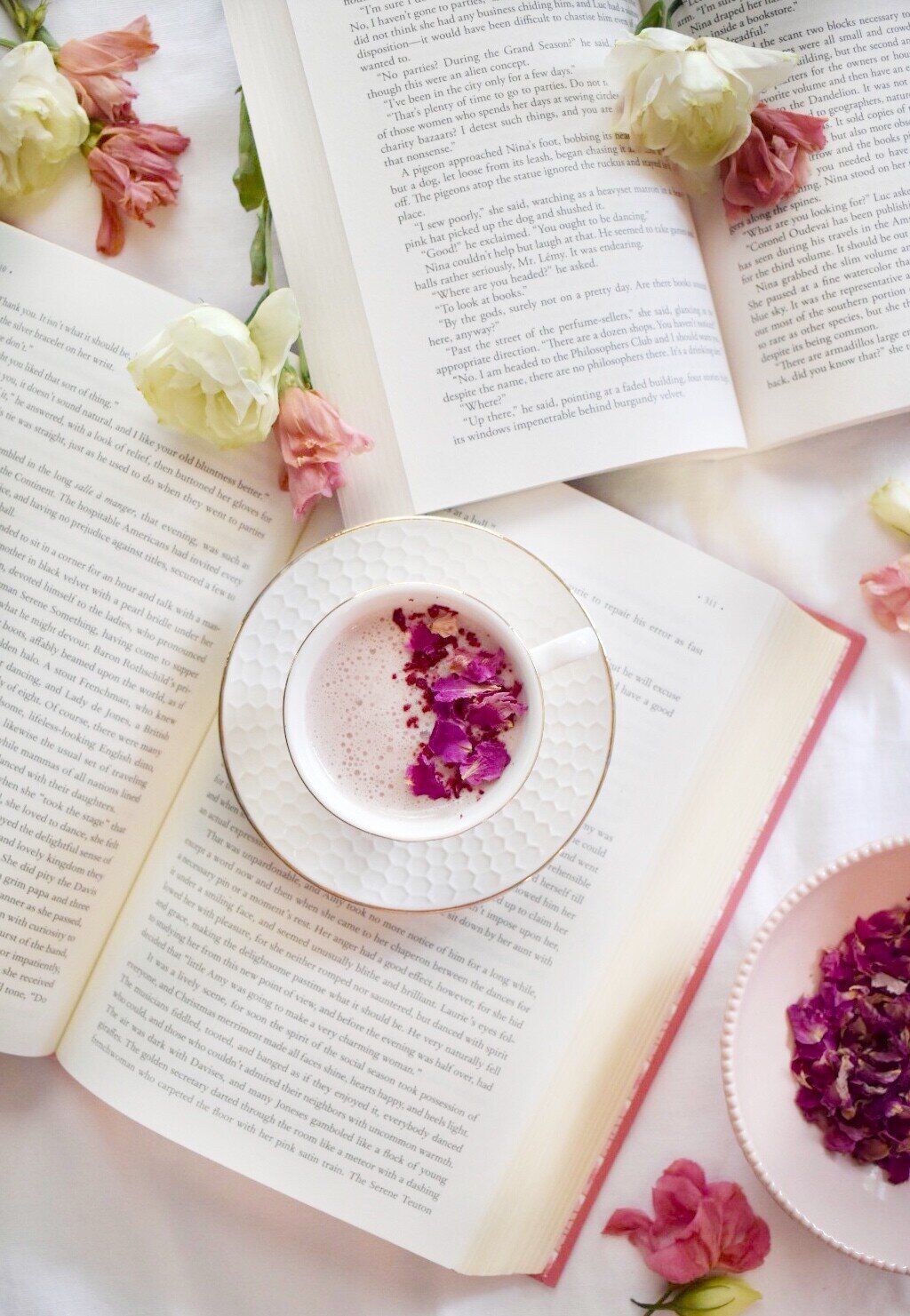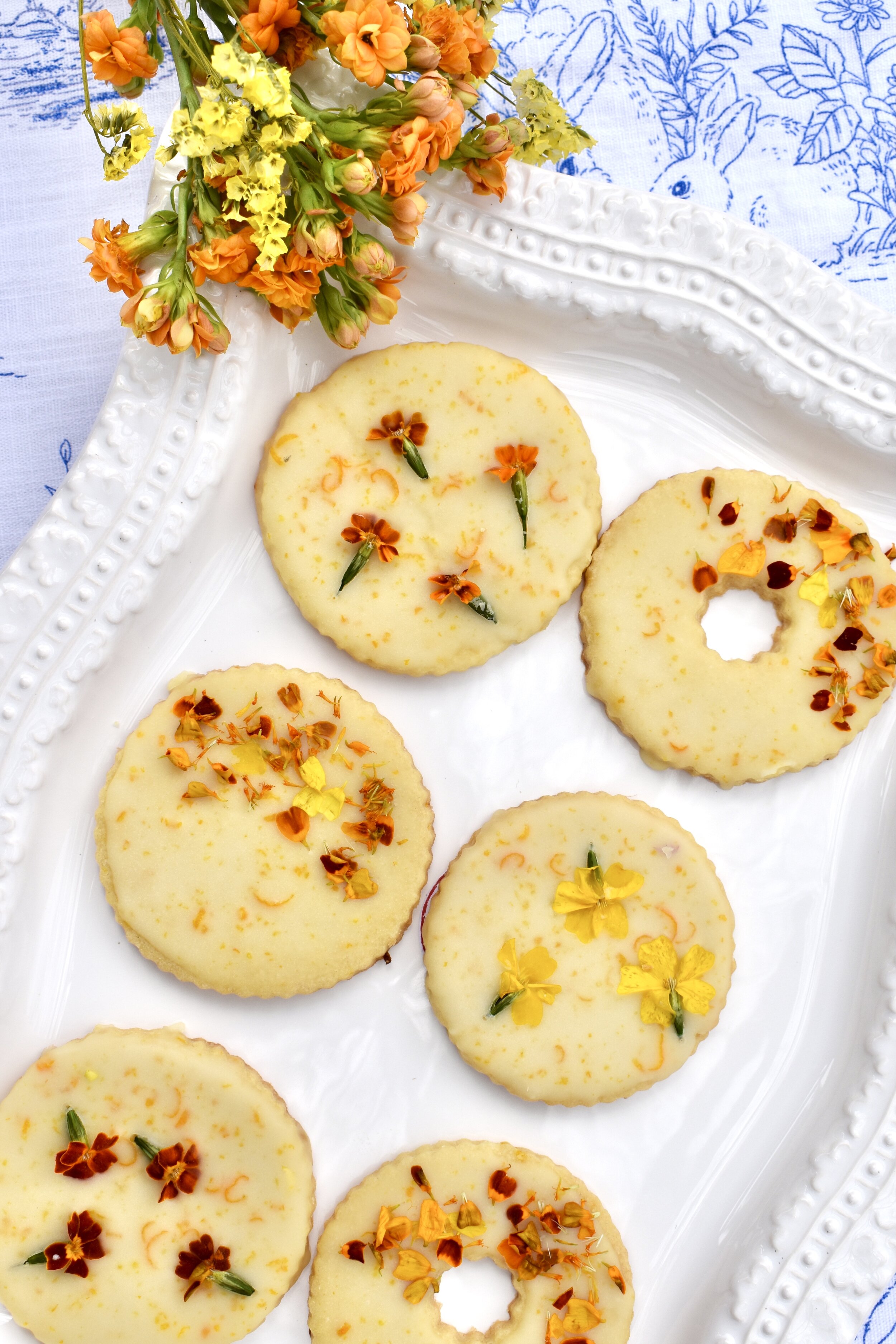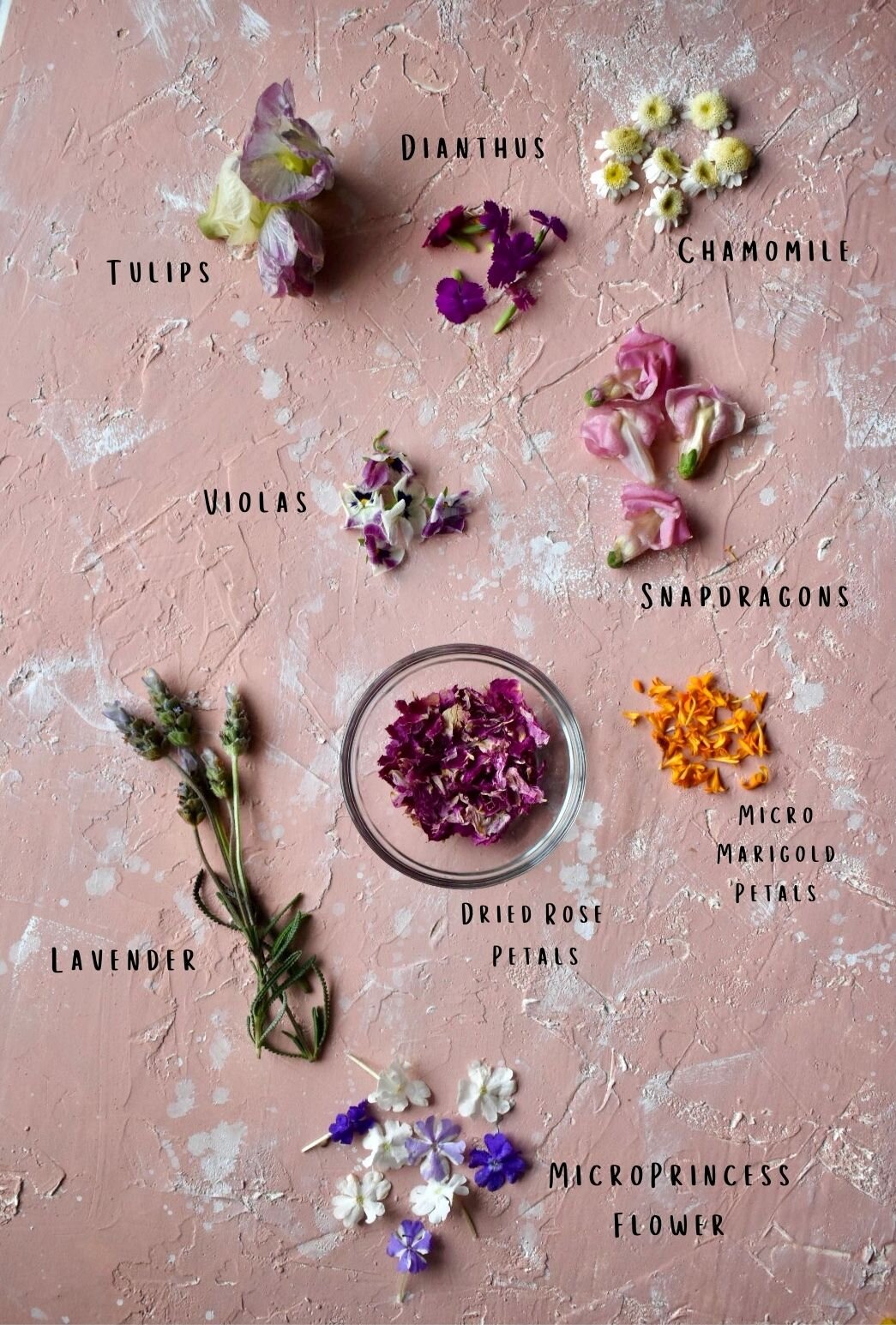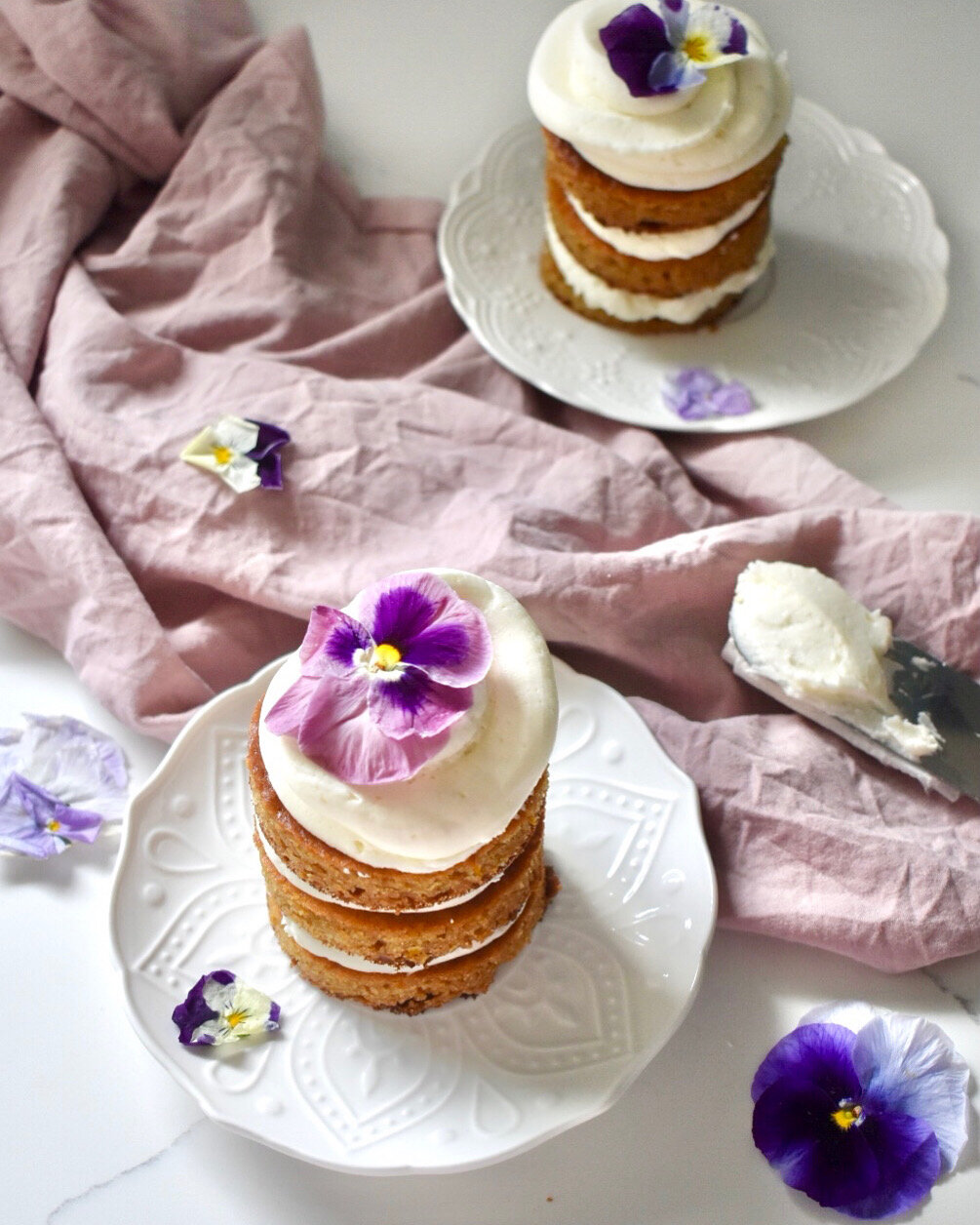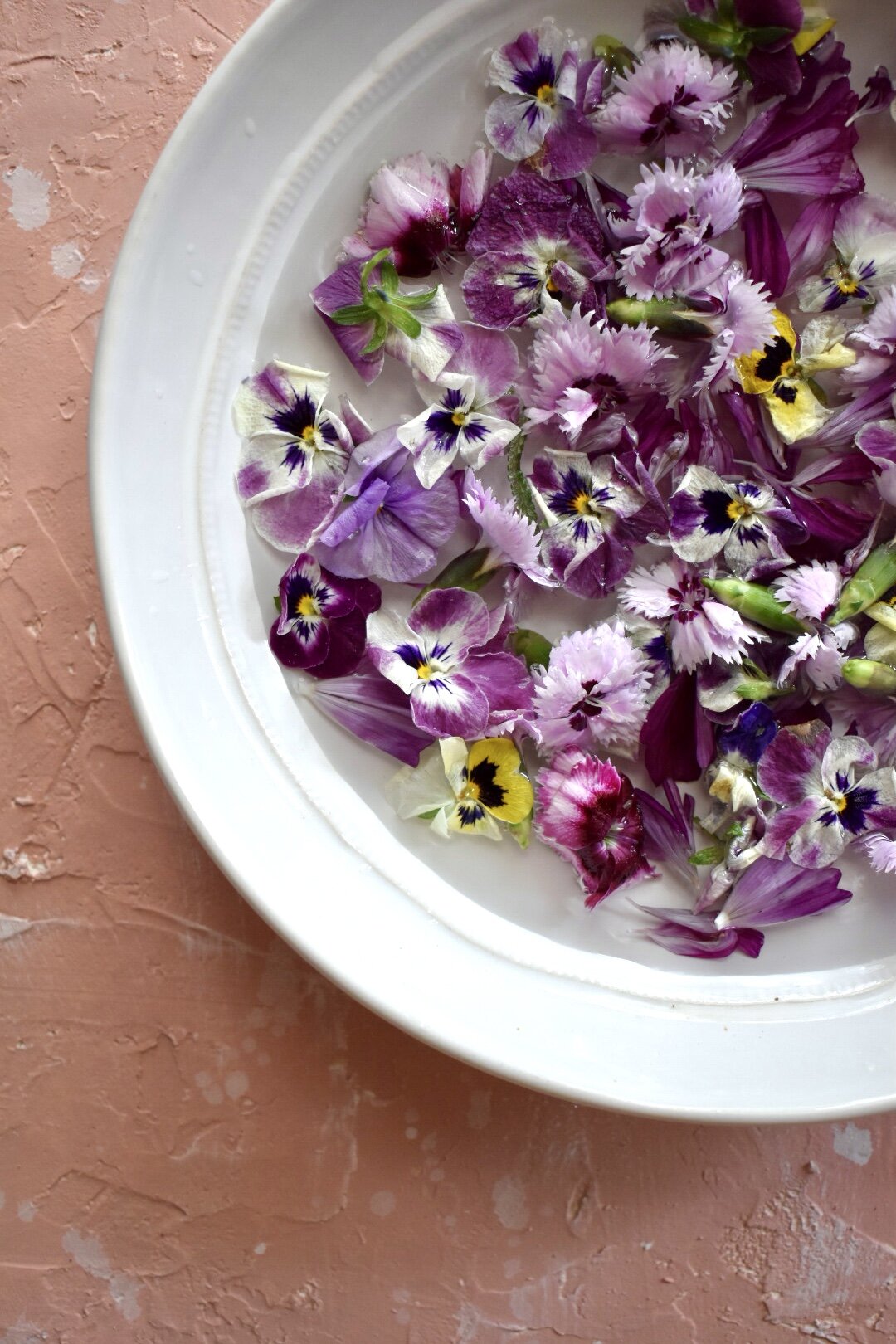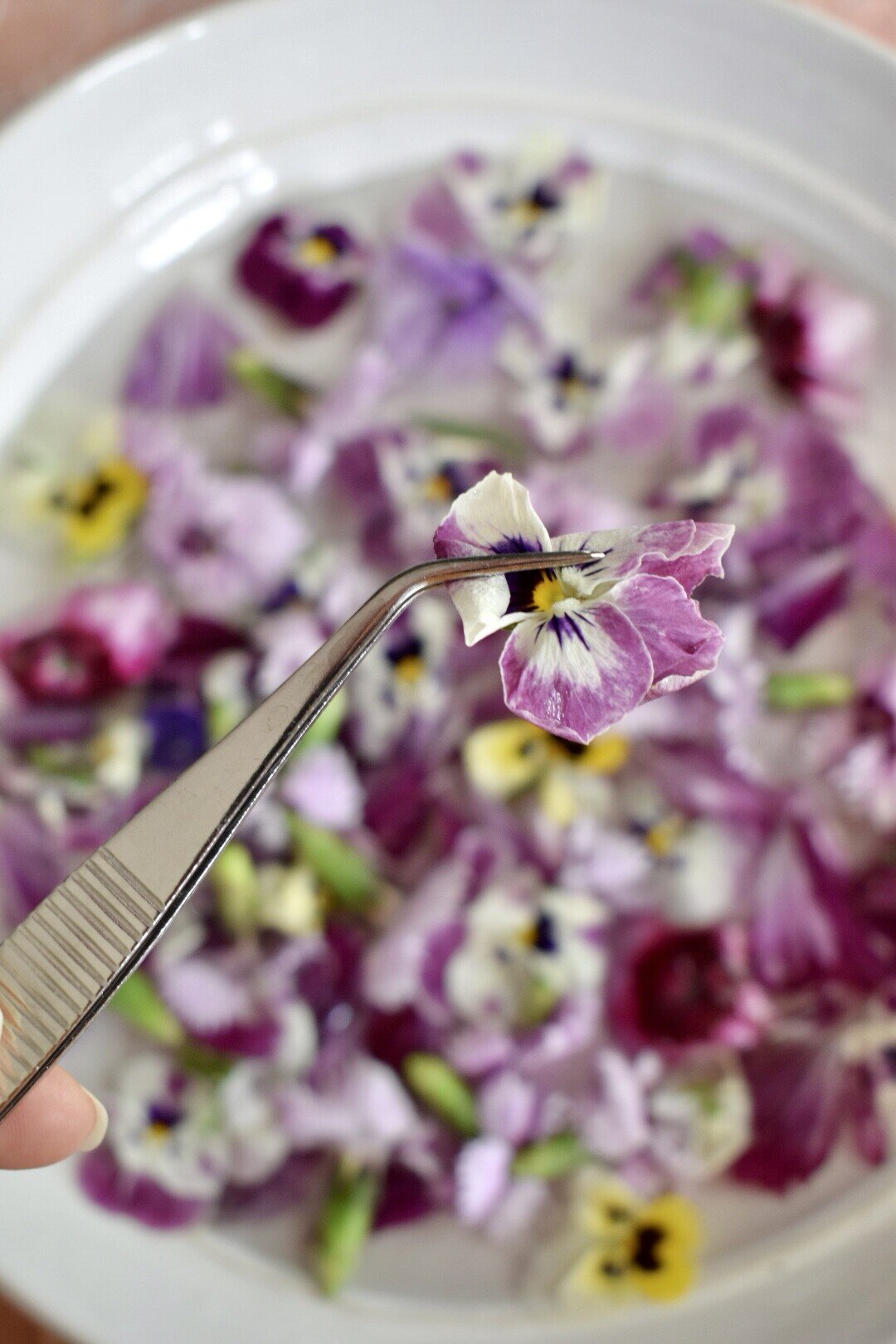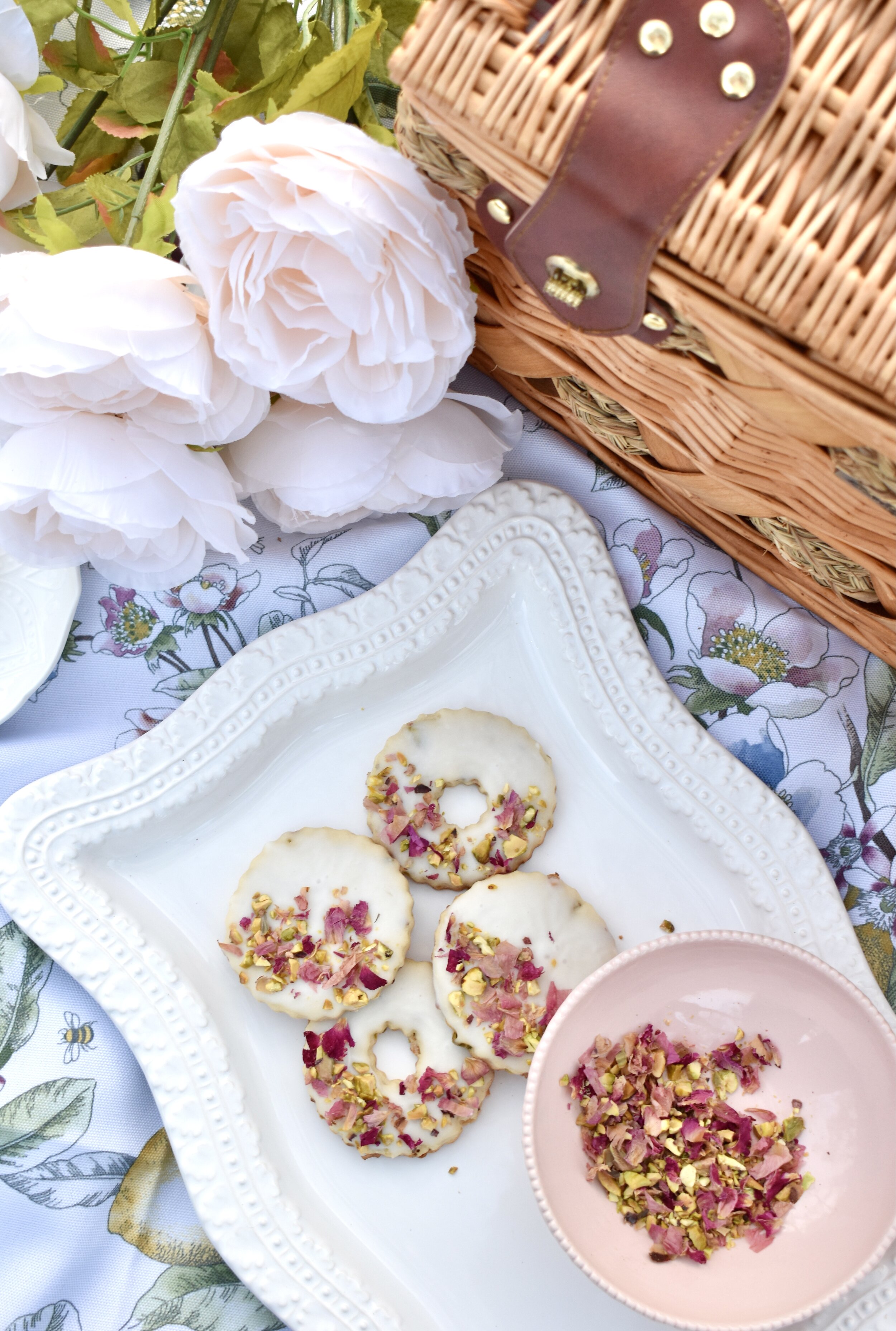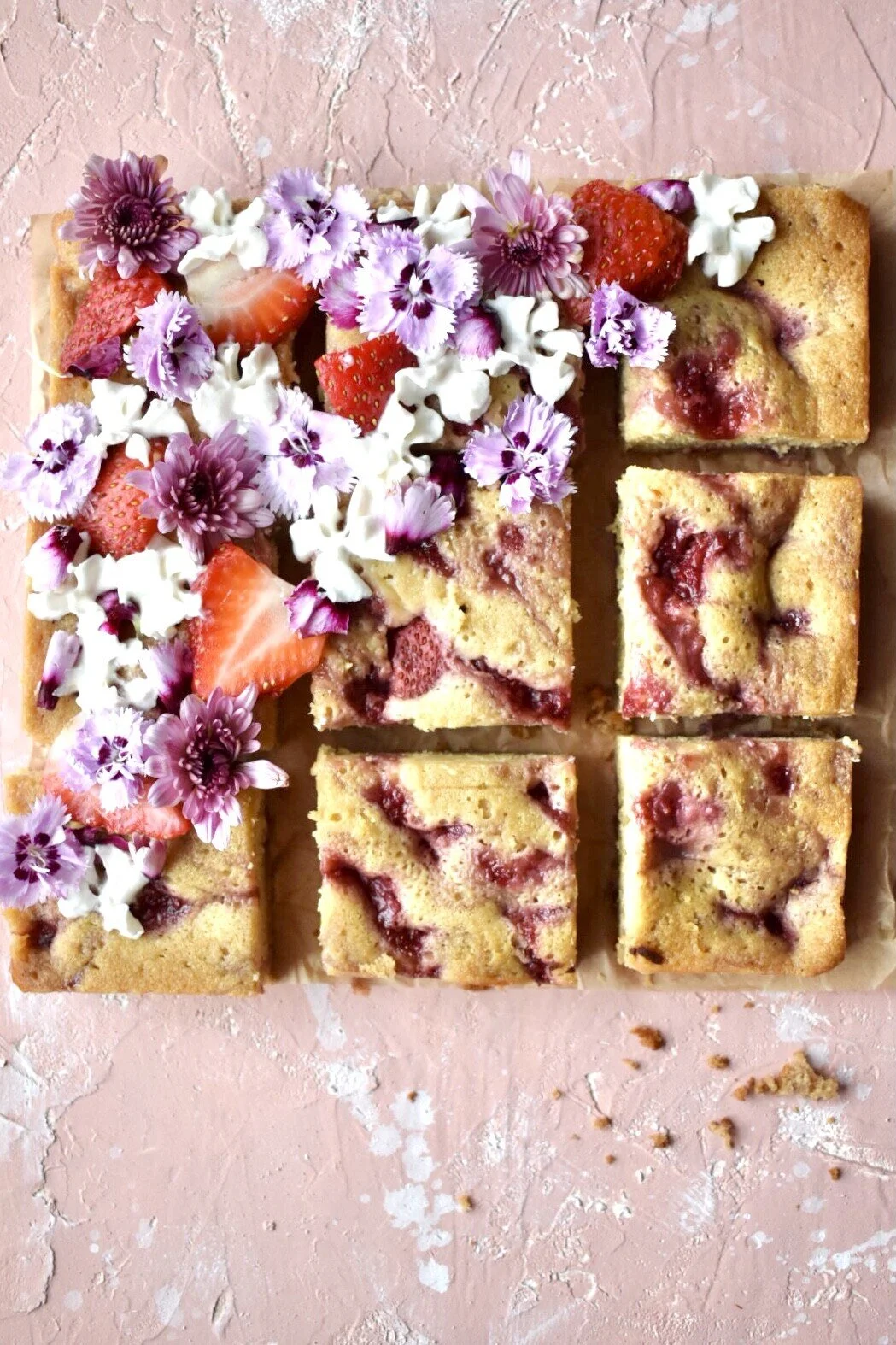How to Prepare Edible Flowers for Cakes, Desserts, and More!
edible flowers are a simple way to elevate any dish!
Whether you are a professional baker or have just taken up botanical baking as a hobby, learning how to prepare edible flowers for use with food can instantly elevate any dessert.
They have the power to add a touch of whimsy and romance that is sure to wow any crowd!
With that in mind, it’s no wonder edible flowers have been used for years in cuisine and botanical baking.
These delicate flowers are making a comeback as more people are being drawn to the simple yet elegant style of dessert decorating inspired by nature.
In this article, you’ll find:
There is something truly enchanting about using real flowers in baked goods. They provide a natural beauty that cannot be easily replicated.
You can use edible flowers in various ways, from creating magnificent garden-style wedding cakes to simply serving as a styling prop for your grazing boards. However, there are a few steps to keep in mind to prepare edible flowers to be safe for decoration or as part of the batter. Let’s dive in!
The Basics of Using Edible Flowers in Baking
Micro marigolds on perfect orange treats.
For some, it can seem out-of-the-ordinary to think that you can eat flowers.
But in reality, the use of edible flowers dates back centuries. They are much like herbs and can add a pleasant (and sometimes earthy) taste and aroma to your baked goods. For example, the micro marigold flower is one that is great to use with baked goods and has an amazing aroma. It has the scent of sweet orange and has a slight citrus taste that works great with orange-flavored desserts.
Let’s talk about some of the basics of working with edible flowers and other botanicals. While the overall goal is to inspire you to get creative and have fun with your designs, there are a few rules to keep in mind to ensure that the flowers you are using are completely safe and edible.
Crucial Tips for working with edible flowers:
Always research how the flowers are grown before purchasing from any vendor.
Never use flowers that you got from a florist, floral wholesaler, or garden center, as some of these are sprayed with pesticides and fungicides and can be toxic for ingestion.
Consider if there are pollen allergies for anyone who would be consuming the flowers.
As with all herbs and botanicals, consult a physician before consuming if you’re pregnant.
Make sure the flowers are fresh to prevent mold build-up.
Keep flowers refrigerated or preserved by pressing.
Check for small insects before adding the edible flowers to baked goods.
While it’s important to proceed with caution, remember to have fun through the process and give yourself creative freedom when styling your desserts!
Below, you’ll find a detailed look at these topics, with tips and tricks to help you learn the ins and outs of working with edible flowers.
Common Edible Flowers
As mentioned above, edible flowers are very similar to herbs. Some can serve medicinal purposes, such as chamomile flowers.
At other times, the flowers you use may have no intense flavor but can serve as an eye-catching decoration.
Listed below are some of the most common and easily obtained edible flowers. This is not an extensive list, but it will give you a good starting point!
Common Edible Flowers:
Pansies
Violas
Micro Marigold
Micro Dianthus
Chamomile
Dandelions
Fennel
Cucumber florets
Squash florets
Dried lavender
Dried rose petals
Most edible flowers can be easily grown in your own backyard. Remember that most of our fruit grows from a flower. From tomatoes to cucumbers, first a blossom appears on the vine, and then the fruit follows.
However, not all garden flowers or wildflowers are considered safe for eating. You should always take proper precautions to be completely certain that anything you ingest is safe for eating.
Plants can carry pests or pesticides depending on how they are grown, and some can even be dangerous to consume. Therefore, never assume that because one part of the plant (such as the fruit) is edible, the rest of the plant is safe to eat.
But if you want to learn more about different flowers that are safe for eating, there are wonderful books and articles that go into more detail.
Important note: As a rule of thumb, always consider pollen allergies when working with edible flowers. If you suffer from severe pollen allergies, even the slightest bit of pollen can trigger a reaction. It’s always best to sample a small part of the flower first or consult a medical professional before ingesting. It’s also important to note that you should always clearly state this on the list of ingredients as a possible allergen to keep everyone safe if you are serving guests or customers.
These sweet pansies bring a sense of whimsy to these iced tea cakes.
Where to Buy Edible Flowers
While it is becoming more and more popular in the U.S. to use edible flowers, it isn’t a common household practice like it is in other parts of the world, such as Europe and Asia.
In much of Europe, especially in the countryside, many wildflowers grow in fields that can be consumed. But unless you are familiar with botany or herbalism, it is not recommended to use just any wildflower you see on the side of the road for consumption.
It is always a best practice to know where the flowers are being sourced from.
Things to consider when sourcing edible flowers:
Research, research, research! I can’t stress this enough. Like with any food you are to consume, you want to make sure it is safe. Look for certified growers and farms that focus on growing and harvesting flowers, knowing that they will be consumed. This will ensure that they are free from pesticides, fungicides, and pests.
When able, buy dried florals labeled edible and organic or culinary. This is the best way to know for sure they are safe and grown as naturally as possible.
Source from local farms specializing in growing edible flowers whenever possible. You can connect with the owners/farmer and learn their exact methods for growing and harvesting, all while making sure they are grown using safe methods for human consumption.
Check your local specialty supermarkets. Some supermarkets have started adding edible flowers in their salad sections. As always, read the labels carefully to ensure where they are coming from.
Some of the places I have found to be incredibly resourceful for quality edible flowers include the following:
Gourmet Sweet Botanicals: They have a great selection of edible flowers, herbs, and microgreens. They are very transparent about how they source their flowers and provide any information you need. They also ship your flowers out the very next day so you get the freshest flowers possible.
Fresh Origins: This source is one of the distributors to Gourmet Sweet Botanicals, mentioned above. This is another great resource for buying edible flowers in bulk for larger orders.
Framed Florals: This is an excellent source for dried edible flowers if you don’t have time to press them yourself. Lacie, the owner, is an expert at pressing florals. And while she does not grow her own edible flowers, she does source them from a local farm that uses safe growing methods, and then she uses safe practices to press them to preserve them herself.
Using dried flowers would be the perfect way to try out using edible flowers!
Culinary-Grade Dried Herbs and Edible Flowers
A good starting point to regularly working with edible flowers is to begin by using dried edible flowers or herbs.
Dried edible flowers are easier to work with and have a long, stable shelf-life because they are preserved through the drying process.
Some of my favorites to use are dried culinary-grade lavender and dried rose petals.
Cleaning and Preparing Edible Flowers
Now that we have established some of the basics of working with edible flowers and how to source them, we can move onto the fun part: using them in design and being creative!
It can feel a bit overwhelming when you first start working with edible flowers. But I promise once you learn the few basics of how to source and prepare edible flowers, the process becomes much easier, and you can focus more on the styling and design.
Below are the steps you’ll need to follow to prepare edible flowers for use on any desserts. You’ll need the materials listed out below (and a little bit of patience!).
Materials Needed:
Edible flowers
Paper towels
Cookie tray or sheet pan
Flower tweezers (optional)
Bowl filled with lukewarm water
Strainer
How to Clean Edible Flowers
Fill a bowl with lukewarm water. (Take caution that the water isn’t too hot, as this can damage the flowers.)
Place the flowers in the bowl and let them soak for a few minutes, gently rotating them to wash the water over both the petals and stems.
Gently use the strainer to allow the water to run off the flowers. (You may need to repeat this step several times if you are using many flowers.)
Using a cookie sheet pan, lay out two layers of paper towels. This will serve as a drying surface for your flowers.
Gently pick up larger flowers individually using the tweezers or your fingers, and carefully inspect for any small insects. If you find any, they can be removed with tweezers. (Remember, it is completely normal if the flowers have some insects on them, but if they have too many, you can omit using these or try to spray them directly with running water from the sink.)
Lay out the flowers on top of the paper towels, leaving room in between each flower, so they don’t stick together. Gently fold the paper towel over and press down to soak up any water left on them.
Let them dry off in a cool place for at least 10 minutes before using. (Don’t place near windows as the heat may wilt them).
You are now ready to use the flowers on your desserts! I like to use fresh edible flowers, but if you want to take it a step further, you can press the flowers in between the pages of a book for a few days using parchment paper to press and dry them before use. And if you are using frosting, the sugar will help preserve the flowers’ life.
It is imperative to wash the flowers you intend on using in your baked goods.
Using a flower strainer allows you to easily sift your washed edible flowers.
Flower tweezers are the perfect tool for grabbing small, delicate blooms.
Decorating with Edible Flowers
The thing that makes edible flowers so special is that each flower has its own unique properties.
Even though they may be the same type of flower, each bud differs slightly from the other. From the color hue to the lines on the petals, they’re all unique and special—just like us.
This is what makes working with edible flowers so lovely. Each design will vary slightly and have its own flare!
Ways to Style Desserts with Flowers
Use the flowers as part of the batter. This technique is especially great when you’re using dried flowers and herbs, such as lavender and rose petals.
Create a visual effect with the flowers by decorating one portion of the desserts and leaving the rest of it natural. This works great with brownies, bars, and cheesecake, or any type of dessert that is cut into slices and is viewed from the top.
Sometimes simple is the route to go. By adding one flower to cupcakes, you can really transform it into a delicate, romantic dessert that is great for weddings.
Go wild with flowers. Transform your cakes to look like you pulled them straight from a fairytale garden by making the flowers the main focus and decorating with flowers all around.
Working with flowers in baking is an art form. Styling is all about bringing your personal touch and vision into your work. So don’t be afraid to experiment with a variety of edible flowers when designing. Truly have fun with the process. Allow yourself the creative freedom to bring your visions to life!
Edible Flower Recipe Ideas and More
Once you have prepared the flowers to add to your desserts, it’s time to get baking!
There are so many possible flavor combinations, but I find that a blend of natural flavors, such as adding fresh fruit into the batter, works well when using edible flowers. The more natural ingredients you can add to your baked goods, the more freshness will come through the palette.
Some of my favorite flavor combinations when using flowers and fruit include the following:
Aren’t these pistachio and rose cookies are lovely? And they’re scrumptious to boot!
Pistachio & Rose
Lemon & Lavender
Orange & honey paired with micro marigold
Chocolate & Rose
Berries & Dianthus
Vanilla & Pansies
Chamomile & Lemon
Strawberry Vanilla Cake Bars
If you are looking for a good recipe to put your new edible flower skills to the test, search no further.
Below you’ll find a super easy and delicious recipe for Strawberry Vanilla Cake Bars.
This recipe combines a blend of natural, fresh ingredients that are the core of botanical baking. A combination of fresh strawberries and honey takes the classic vanilla cake to the next level. Listed are the ingredients you will need and the steps for preparing your cake batter.
Recipe details:
Preheat your oven to 350℉. This recipe makes 9 servings. Prep time is 15 minutes, with the total recipe time being 45 minutes.
Cake Ingredients:
¾ cups of flour
½ tsp baking soda
Pinch of Himalayan pink salt
1 egg
½ cup honey
½ cup (full fat) coconut milk
1 ½ tsp vanilla extract
¼ cup coconut oil
Strawberry Jam Filling Ingredients:
This step is optional. You can also use store-bought jam if you have that on hand.
8 large strawberries for jam and 2 more for decorating
1-2 tsp honey
1 tbsp lemon juice
Preparation:
Strawberry Jam Filling
Chop the strawberries and add them into a small saucepan along with the honey and the lemon juice.
In a saucepan on the stove, set heat to a low setting and allow them to come to a simmer while gently stirring.
Once the strawberries have softened, mash them and strain them to prepare the jam filling. Straining the jam will remove excess seeds.
Vanilla Cake
Prepare a square 8x8 baking pan by spraying with non-stick oil spray and a layer of parchment paper.
In a large bowl, combine the flour, baking soda, and salt. Set aside.
In a separate bowl, whisk together the egg, coconut milk, vanilla extract, and honey. Add the wet mixture to the dry mixture and combine well.
Gently fold in the coconut oil until well blended.
Pour the cake mixture into the baking pan, and then add the strawberry jam filling on the top in dollops.
Create a marble look with the jam using a toothpick to form swirls. Add a few more strawberries to the top of the batter and bake at 350℉ for 25-30 minutes or until golden brown.
Allow to cool completely before decorating. Top with edible flowers. Cut into 9 squares and enjoy!
Carefully designed botanical treats have a lasting impact on guests and add the vibrant art of floral design to edible goods. Enjoy livening-up your desserts (such as this strawberry vanilla cake!) and events with edible flowers.
Pairing florals with fruit enhances both flavors and will wow your tastebuds!
Don’t be afraid to get creative with your dessert designs.
Trust me, this cake is as delicious as it looks!


